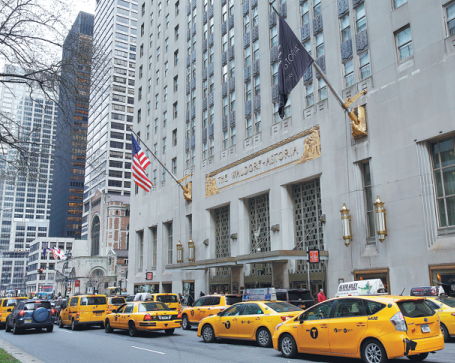Waldorf gets revamp with $1b makeover
Chinese owners transform icon into condo-hotel to revive its former glory

New York's famed Waldorf Astoria Hotel is undergoing a $1 billion renovation by its new Chinese owners who have repurposed the hotel and look to revive its former glamour.
The iconic building located on Park Avenue in midtown Manhattan was closed two years ago to commence its transformation into a condo-hotel hybrid by its new owner Anbang Insurance Group. Dajia Insurance Group took over the assets of the defunct Anbang earlier this year.
Since Anbang purchased it in 2015 for $1.95 billion, the hotel has been painstakingly transformed. In addition to 375 hotel rooms, some rooms have been overhauled to create 375 condos.
The Art Deco-inspired condos, called The Towers of the Waldorf Astoria, were designed by Louis Deniot, a Paris-based architect.
The building's exterior, which has landmark designation of New York, has been updated as well.
The hotel rooms for "royals, presidents and guests" will reopen in 2022. The hotel's new public spaces are being designed by Pierre-Yves Rochon.
Andrew Miller, CEO of Dajia US, is confident that the luxurious units that start at $1.7 million for a studio and will include a mix of sizes will lure domestic and international buyers. They will be listed for sale in February.
"The heritage (of the Waldorf Astoria) … is a really significant thing," Miller told China Daily.
"The location of the building and the heritage… bring a level of stability that is very reassuring for people in an uncertain world," he said.
However, the Waldorf's residential splash into the market comes at a challenging time for New York's real estate sales, as there is a glut of condos. There is also a mansion tax that could sting high net worth buyers.
The residential units will have entrances and elevators separate from the hotel entrance, so that guests "never have to mix" unless they want to, Miller said
Each condo has a residential closet that locks from both the outside and inside for package deliveries. The residential lobby will feature marble floors, mirrored ceilings and a seating area.
Residents will have access to their own 25-meters pool, fitness center and spa.
Built by competitive cousins William Waldorf and John Jacob Astor IV, the original Waldorf Hotel first opened at 33rd street and Fifth Avenue in 1893. Four years later the Astoria was constructed next door. When they were combined, they created the largest hotel in the world. The hotels even had an alley separating the buildings because their relationship was so fraught.
By the 1920s, the Victorian-era Waldorf Astoria had become outdated, and was demolished in 1929 to make way for the Empire State Building.
Hotel manager Lucius Boomer purchased the "Waldorf Astoria" name and raised money to build a grander version of the hotel on Park Avenue, which opened in 1931.
The Waldorf offered radios in all 2,200 rooms and even "manufactured weather," an old-fashioned name for air conditioning.
Place in history
Hollywood stars, royalty, presidents and prime ministers helped cement the hotel's place in history.
US president Ronald Reagan and his wife Nancy, British prime minister Winston Churchill, singer Frank Sinatra and actors Gregory Peck and Zsa Zsa Gabor all spent nights at the Waldorf.
When he was US president, Franklin Roosevelt used to arrive at the hotel on a private railroad car on a platform that was built under the hotel, close to Grand Central Station.
Herbert Hoover lived at the Waldorf for more than 30 years after he left the White House in 1933. Every US president since Hoover has stayed at the Waldorf.
Barack Obama was the first US president not to stay at the hotel after its sale in 2015. The developers of the project have built new hotel suites for world leaders.
Composer Cole Porter lived in Room 33A, a six-bedroom suite at the hotel. There he wrote songs such as I've Got You Under My Skin and Let's Misbehave.
Dan Tubb, senior sales director for The Towers of the Waldorf Astoria, said: "It's incredibly important for us (to honor the past) because whether it's the past of what people remember over the last few decades, it's an integral part of the passion people have for this building. It's been wonderful to work with (Dajia) to restore the original details."
Another familiar sight will be the Grand Ballroom, which has been moved to the third floor, minus the chandelier. It was pieced back together using pictures and the original floor plan.
A clock commissioned by England's Queen Victoria for the 1893 World's Fair in Chicago also will be a feature. It has a small Statue of Liberty on top along with four sides showing the time in New York, Madrid, Tokyo and Istanbul. The clock, once located in the lobby, has been restored by a company in the Hudson Valley and will have a place in the renovated building.
"The entire development team, not just (Dajia), but the hundreds and hundreds of consultants, each of them the very best at what they do, is very aware of the responsibility we have that this is a global icon and one of New York's most important cultural institutions," Miller said.

Today's Top News
- Hainan FTP launches intl services portal
- HK's Jimmy Lai convicted in national security case
- China announces countermeasures against former Japanese senior official
- Australia set to further tighten gun control laws
- HKSAR security chief on conviction of Jimmy Lai
- Jimmy Lai's verdict sends clear messages






























